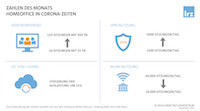LRZ-Newsletter Nr 04/2020 of April 2nd 2020

You will find this newsletter in German on the LRZ-Website
Our Topics:
- News
- Study and work with LRZ
- Job Opportunities
- More to Read
- Informations about the LRZ-Newsletter
- Imprint
News
LRZ: Open for Your Questions
The Leibniz Supercomputing Centre (LRZ) is closed to visitors until Sunday, 19 April. This means:
- The service desk can still be reached via the ticket system and by phone at 089/35831 8800. However, it has discontinued its presence consultation.
- There are currently no workshops or courses - neither for PC nor HPC use. The LRZ is working on digital courses, interested parties can find out the dates at short notice on the course page as well as on Twitter or Linkedin or in the next newsletters.
- All events and guided tours at the LRZ are cancelled.
- Ordering and printing of publications and posters: Until further notice, publications and posters cannot be collected at the LRZ or in the central libraries of the LMU and TUM. Also the user secretariat is currently only available electronically and digitally. Please understand the security of staff and librarians.
The LRZ continues to operate the IT and web services in the usual quality. As most of the LRZ users are currently working at home, there is currently a lot of access to network services, Virtual Private Networks (VPN), e-mail services, cloud storage and LRZ Sync + Share. Therefore these services are continuously monitored and resources are scaled on demand. Stay healthy - and inform yourself at short notice on the LRZ website, on Twitter or Linkedin.
Computing Time for Corona Researchers
 Finding new vaccines and
therapeutics, analysing and forecasting
spread scenarios for contingency planning, exploring the virus and its
behaviour: The Leibniz Supercomputing Centre (LRZ) offers support and
services for research projects on the coronavirus. Scientists who
calculate, simulate and model pandemic data are provided with
high-performance computing resources in Germany by the Gauss Centre for
Supercomputing (GCS). Researchers can therefore also use the
SuperMUC-NG and the infrastructure of the LRZ: Here they have
access to the Petascale high performance computer, the compute cloud of
the LRZ and the Linux cluster. The HPC and data specialists at the LRZ
also support the rapid optimisation of applications and simulations
around COVID-19 for the calculations on the supercomputers.
Finding new vaccines and
therapeutics, analysing and forecasting
spread scenarios for contingency planning, exploring the virus and its
behaviour: The Leibniz Supercomputing Centre (LRZ) offers support and
services for research projects on the coronavirus. Scientists who
calculate, simulate and model pandemic data are provided with
high-performance computing resources in Germany by the Gauss Centre for
Supercomputing (GCS). Researchers can therefore also use the
SuperMUC-NG and the infrastructure of the LRZ: Here they have
access to the Petascale high performance computer, the compute cloud of
the LRZ and the Linux cluster. The HPC and data specialists at the LRZ
also support the rapid optimisation of applications and simulations
around COVID-19 for the calculations on the supercomputers.
New insights around the highly contagious virus are urgently needed: The world needs vaccines or effective cures to protect against infections and to contain its spread. For this reason, the LRZ has shortened the application procedures for COVID-19 research and removed obstacles on the way to the supercomputers. In particular, high performance computing can advance research into the coronavirus on the molecular level and improve the understanding of its mode of action. In addition, supercomputers can analyse active substances for the development of vaccines and therapeutics very quickly. Last but not least, crisis managers and politicians now need meaningful prognoses on the spread of the virus and empirical values for quarantine measures. HPC helps to evaluate data from a wide variety of sources and countries.
Simulating the Human Being
 How
does the blood flow and what happens in the vessels? Scientists and
physicians can now simulate this. The images of red blood cells were
calculated by the SuperMUC-NG of the Leibniz Supercomputing Centre
(LRZ) based on the data of the Swiss
IT'IS Foundation. They are a further milestone in the EU project CompBioMed. Its
goal is a virtual model of the human being - and with the growing power
of high and supercomputers, this is now being simulated more accurately
and in greater detail. Big data, artificial intelligence and machine
learning now also complement modelling and create more perspectives for
research, medicine, the pharmaceutical industry and medical device
manufacturers.
How
does the blood flow and what happens in the vessels? Scientists and
physicians can now simulate this. The images of red blood cells were
calculated by the SuperMUC-NG of the Leibniz Supercomputing Centre
(LRZ) based on the data of the Swiss
IT'IS Foundation. They are a further milestone in the EU project CompBioMed. Its
goal is a virtual model of the human being - and with the growing power
of high and supercomputers, this is now being simulated more accurately
and in greater detail. Big data, artificial intelligence and machine
learning now also complement modelling and create more perspectives for
research, medicine, the pharmaceutical industry and medical device
manufacturers.
CompBioMed held a three-day working meeting on machine learning methods for simulation and modelling in mid-March, which could only take place virtually due to the coronavirus. "During the conference, we discussed how computational science and IT technology can contribute to solving concrete problems in biomedical research," reports David Wilfing,who holds a PhD in medical chemistry and is the new project lead for CompBioMed at LRZ. "In addition to high-performance computing and simulations, big data, machine learning and artificial intelligence play a major role in this project, for example when it comes to researching drugs and active ingredients."
Support for Data Management
The LRZ has been supporting CompBioMed since 2016, since 2019 it has been the main partner in the project and is particularly responsible for the analysis and management of large amounts of data. Now, the LRZ is mainly concerned with the management of research data. For this purpose the bavarian Supercomputing-centre offers the innovative LRZ Data Science Storage System as well as tools for automated high-througput analysis of Big Data and for data security. CompBioMed also demands the LRZ team for Big Data and artificial intelligence.
CompBioMed is only one example of how supercomputing enriches the life sciences. The virtual human model, on which Coveney and researchers, universities and computer centres in Europe and the USA have been working since 2015, is not only intended to be an electronic research and illustrative object. Over the years, a library of about 20 simulation programs and codes has been created from it, which can be used to calculate and simulate the movement of muscles and bones, biochemical and molecular processes as well as blood flow, heart and vascular processes.
Behind the high-resolution images of the red blood cells is the CompBioMed program HemeLB. Together with the software for displaying proteins, this could also help to develop strategies or active substances against the coronavirus. It is quite possible that CompBioMed will now also develop software that will calculate the spread of a pandemic and help to plan quarantine measures in the future.vs
Support from the LRZ-Cloud
 Quick help: In just under two weeks, the Leibniz Supercomputing Centre
(LRZ) with its compute cloud has provided sustainable relief for the German Research Network
(DFN). After the closure of universities and research institutions
in mid-March, the use of communication and web services at DFN also
increased massively, especially through video conferences and meetings
of the conference service DFNconf.
"With 10 virtual machines in our compute cloud, we now provide DFN with
server capacities," explains the Compute-Cloud-Team. "The setup was a
time-consuming job, we didn't have a use case like this here yet".
Quick help: In just under two weeks, the Leibniz Supercomputing Centre
(LRZ) with its compute cloud has provided sustainable relief for the German Research Network
(DFN). After the closure of universities and research institutions
in mid-March, the use of communication and web services at DFN also
increased massively, especially through video conferences and meetings
of the conference service DFNconf.
"With 10 virtual machines in our compute cloud, we now provide DFN with
server capacities," explains the Compute-Cloud-Team. "The setup was a
time-consuming job, we didn't have a use case like this here yet".
1300 Video Calls More
Specifically, the virtual servers for DFN occupy five real SR630 servers from Lenovo, each with 80 CPU cores (2x40) in the cloud. They have been running "productively" since 25 March, thus proving themselves in the virtual research environment. "With the additional nodes from the LRZ we create space for about 1300 additional video participants or 5300 audio calls", reports Christian Meyer, responsible for video conferencing at DFN. "So this is a big gain." As the graph shows, the processors (CPU) are now particularly challenged in the time between about 8 a.m. and 4 p.m., after which the demand for video communication apparently decreases, but some scientists are even active at DFN until night - possibly because they coordinate internationally.
DFN's support will continue as long as scientists are working in their home offices because of the corona virus. DFN is an association that networks universities and research institutions and provides communication and web services to scientists for research and teaching. vs

User-friendly Data Transfer for HPC
For the EU project LEXIS (H2020 Grant Agreement 825532, 2019-2021), researchers, data centers and industry are currently working on a platform for workflows that combine high-performance computing (HPC), cloud computing and big-data processes. "HPC-Cloud-Big-Data-Convergence" is a nice buzzword - with LEXIS, benefits for scientists and industry should grow from it. The Leibniz Supercomputing Centre (LRZ) and IT4Innovation (IT4I) from the Czech Republic are the driving forces behind this project.
Using clouds and supercomputers – that sounds simple. But if you have to move terabytes of data back and forth, control workflows from several process steps and also want to manage this data systematically at the same time, you will soon despair. The LRZ therefore tries to improve this work: The Research Data Management team at LEXIS is responsible for work package 3, "Data System" and aims to make the use of Big Data in scientific computing as easy as data processing and exchange with LRZ Sync+Share or services like Google Drive. "This is a dream at first," says Stephan Hachinger, who leads the team on research data management at the LRZ, "but at LEXIS we are taking big steps, for example, standardizing data access to prevent LEXIS users from getting lost in separate folders on IT4I and LRZ".
New Interface, Efficient Storage
 With LEXIS, the LRZ relies on
distributed data infrastructure and on
a platform that was developed on the basis of the openly accessible
data management software Integrated
Rule Oriented Data System (iRODS) and B2SAFE, a
program from EUDAT for the distribution and long-term storage of big
data. This gives users an overview of all their data and enables them
to retrieve it in a uniform way, regardless of whether it is located at
IT4I or LRZ. Where the system stores data is decided on the basis of
rules that are imperceptible to the user, such as whether a backup copy
is necessary or whether the data is made available for quick access.
With LEXIS, the LRZ relies on
distributed data infrastructure and on
a platform that was developed on the basis of the openly accessible
data management software Integrated
Rule Oriented Data System (iRODS) and B2SAFE, a
program from EUDAT for the distribution and long-term storage of big
data. This gives users an overview of all their data and enables them
to retrieve it in a uniform way, regardless of whether it is located at
IT4I or LRZ. Where the system stores data is decided on the basis of
rules that are imperceptible to the user, such as whether a backup copy
is necessary or whether the data is made available for quick access.
In addition to this practical platform, Dr Rubén J. García Hernández and Mohamad Hayek from the LRZ's Research Data Management team developed a web-based programming interface for data transfer, which they recently presented during the LEXIS project meeting in Grenoble. This means that one HTTP call, i.e. jumping to a website and entering the desired data store and a target system, is sufficient to transfer data from the LEXIS platform to the SuperMUC-NG or to the IT4I systems. "We have already tested this interface with applications from the field of fluid mechanics, but will now challenge it with more real examples," explains Hayek. "At the Grenoble meeting, ideas for better functionality and backend were discussed, and we are now going to implement them.
For the LRZ, the work on LEXIS offers further exciting facets: for example, the testing of two burst buffer systems for accelerating data transfers. Similar to the IT4I, these systems contain extremely fast NVDIMM and SSD memories and can therefore absorb the streams of terabytes of data during input and output almost without delay. This eliminates annoying waiting times when the computing systems write data. vs
Figures of the Month
The risk of infection from Corona forces the users and employees of the Leibniz Supercomputing Centre (LRZ) into the home office. This is reflected in the usage data of some services: Meet.Lrz.de to organize video conferences is very much needed. While the administrators at the LRZ registered about ten conferences per day with a maximum of 25 participants at the beginning of March, 150 conferences with up to 450 participants are now held. The Email- and Groupware-Team has responded to this - the Virtual Machines (VM) have been upgraded to 16 gigabytes of RAM, a second video bridge has been integrated for load balancing and video transmission has been reduced to a maximum of 640 pixels.
In order to keep in touch with colleagues and still be able to coordinate with each other, the Virtual Private Networks (VPN) are also currently under great pressure: In February, up to 1500 sessions per day took place over them, now there are 5000 at the peak. The number of virtual sessions increased particularly quickly after March 13, i.e. immediately after home or teleworking was ordered at the two Munich universities and the LRZ. At the same time the access to the LRZ servers via Webdisk has almost quadrupled. At the LRZ Sync+Share the utilization increased again by 15 %. On the other hand, the wireless networks (WLAN), which the LRZ is building up in its own house and at its clients, are now used less: Via the LRZ, Eduroam or the @BayernWLAN the Internet was still accessed about 60,000 times on March 17th, but on March 23rd not even 10,000 times. vs

Study and Work with LRZ
Set Passwords Yourself
Password forgotten or misplaced? In order to reset the personal code for services of the Leibniz Computing Centre (LRZ), one of about 3100 master users had to be switched on so far. These master users work at universities, scientific institutes or in the LRZ itself. Recently, everyone can do this themselves: Go to www.lrz.de, top right IDM-Portal, then click on "Reset password" and enter your login plus an LRZ e-mail address. The service desk will then send an automated mail, with which the password can be changed via a link or in the IDM portal. "The link does not always work on smartphones or with strict user settings, so the mail still contains a transaction token, a 16-digit identifier with which the password can be set in the IDM portal", explains Ralf Ebner, PhD computer scientist and group leader Identity Management at the LRZ. Another option is the Personal Unlocking Key (PUK), the emergency password that anyone can set themselves in the IDM portal at any time. With a PUK the password can be renewed directly in the portal.
Agile Programming with Scrum
The new password system was programmed in several steps by the software engineering team at the LRZ since May 2019. The seven-member team around Dr. Simon Graf and Dr. Peter Weinert organized themselves with Scrum, a method for agile project management. "In contrast to a specification sheet, which is based on a 100% rigid solution, Scrum aims at fast results, which are tested and improved by new requirements in everyday life", explains Ebner. "This has proven itself with us, because the team is made up of employees from different LRZ departments, who are each released three half days a week for this purpose". In Scrum, Ebner as Product Owner formulated goals that were broken down into programming work in regular Sprint Plannings or work steps and programmed by the developers.
Better Step by Step
The first version of the password management system was already available in the summer and has so far been supplemented with functions in further steps: The system now takes into account different usage rules and user profiles, is easy for users to understand and is now also used for logging on to the SuperMUC-NG. The software engineering team is already working on the next project "Hummel". Behind the pretty abbreviation for "hosting environment with more verve and love" is the programming of a management system for the web services and websites hosted by the LRZ. (vs)
Old Encryption Mucked Out
The Leibniz Computing Centre is cleaning up: For security reasons, the outdated encryption and security protocols Transport Layer Security (TLS) in versions 1.0 and 1.1 were finally switched off at the end of March. "Users who access the Internet with very old devices should therefore no longer be able to access LRZ Sync+Share and all services for which the load balancer takes over the SSL offloading", explains Helmut Tröbs, group leader network operations at the LRZ, Folgen. "For security reasons, however, you should really consider whether you want to go online with it at all".
Users can check for themselves whether they need to take action: If they call up the website of the Federal Office for Information Security (BSI) www.bsi.de and the website appears in their browser, no further steps are necessary. Otherwise, equipment or at least browsers have to be updated. The following browser versions are affected by switching off the old TLS protocols: Internet Explorer 11 and smaller, Java 7u25 and 6u45, Android 4.3 and lower as well as Safari 6.0.4 or OS X 10.8.4 and Safari 5.1.9 or OS C 10.6.8. In order to be able to use all web services of the LRZ without problems, these versions should be updated as soon as possible for security reasons. (vs)
New Programs for Simulation
Electromagnetic fields, the behaviour of liquids, gases or bulk materials: If you want to simulate with the help of SuperMUC-NG, the Linux cluster and the computer systems hosted by the LRZ, you can now get even more software to do so. Newly installed, for example, is ANSYS/EM, a special software from the manufacturer that can be used to simulate electromagnetic fields or model the propagation of low and high-frequency signals. ANSYS/EM is available at the LRZ computers in the versions 2019.R3 and 2020.R1.
Star-CCM+ from the Siemens PLM suite is also available on the Linux cluster. With this software the dynamics of liquids and gases can be calculated and visualized. Formula student teams at the Technical University (TUM) and the University of Applied Sciences Munich are already using the software to optimize the aerodynamics of their racing cars. Registered LRZ users can access a limited number of Star-CCM+ licenses until February 2021. The TUM in turn has a campus license for the Siemens program, so students and employees can use Star-CCM+ more easily at the LRZ via a power-on-demand license.
Finally, anyone experimenting with bulk and other granular materials can now simulate their behavior with the help of ESSS Rocky DEM. The program is frequently used in the process industry and is made available at the LRZ via a specially set up license server. The service desk will help interested parties to register for ESSS Rocky DEM and the new software.
Online Learning at LRZ
Corona changes the course program of the Leibniz Computing Center. After the Easter holidays, Bavaria's largest scientific computing centre is resuming teaching - in the form of online courses. The first will already take place on 23 April 2020. In cooperation with PRACE and other partners, the LRZ is trying to reschedule as many of the courses that were postponed due to the risk of infection as possible and to include unusual workshops in the summer semester in the program. The course website provides up-to-date information about all events. You can also follow the courses on Twitter, Linkedin or in this newsletter, which is published every first Thursday of a month and the next time on May 7.
For the online courses, the video conferencing systems Zoom Education, Go to Meeting or Webex will probably be used. You will find out in good time how to dial in to the online courses and what technology is required.
- The first online course at the LRZ is OpenCL Programming for Intel's FPGA. It will take place on April 23 and 24 and will give participants an overview of field programmable gate arrays (FPGA), explain their technology and how to use the freely programmable accelerators. The two-day workshop is offered by the LRZ in cooperation with Intel, it combines lectures with practical exercises.
- Optimize HPC Codes will take place from June 8th to 10th, 2020 and will teach participants how to improve codes for supercomputing and how to address all hardware features of supercomputers.
- Finally, on June 17 to 19, PRACE and the LRZ will organize the course on Hybrid Programming in HPC, which will be cancelled in April: The course focuses on the programming language Message Passung Interface (MPI), which can be used to develop applications for HPC clusters and hundreds of shared storage nodes.
Job Opportunities
You will find an international and diverse team in Garching, which is constantly growing. If you don't find a suitable job profile below, please visit the career page of the LRZ or send an unsolicited application. We are LRZ - and curious about you!
- Head of Department Central Services (f,m,d)
- Student Assistant User Administration HPC (f,m,d)
- Student Assistant Web backend and Mobile App Development (f,m,d)
- Student Assistant Web, Java and Type Script (f,m,d)
- Student Assistant for the Licence-Team (f,m,d)
- Student Assistant for the Servicedesk (f,m,d)
More to Read
Here you will find links to the latest information from the German and European supercomputing community and our cooperation partners:
- Publications of the Gauss Centre for Supercomputing (GCS): GCS-News and Inside
- Infoletters of the Gauß-Allianz: March 2020, PDF: 2 pages
Informations about the LRZ-Newsletter
- The LRZ Newsletter is published in German and English. You can find the latest and former editions on the LRZ-Website.
- You have problems displaying the newsletter? Please send a short description of your problem to <NewsletterRedaktion_AT_lrz.de>. Thank You!
- You can subscribe or unsubscribe the LRZ-Newsletter via our website.
- Current information about the LRZ can also be found on Twitter and Linkedin
Imprint
- Herausgeber:
- Leibniz-Supercomputing Centre of the Bavarian Academy of Science and Humanties
- Boltzmannstraße 1
D-85748 Garching - Phone:
- +49-89-35831-8000
- Telefax:
- +49-89-35831-9700
- E-Mail:
- lrzpost_AT_lrz.de
- Editorial Office:
- PR Team
- Photos, Graphics:
- CompBioMed, LRZ, CDC, S. Schooler, A. Serrano, Unsplash.com
